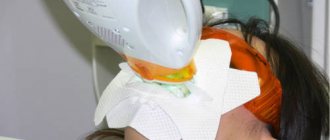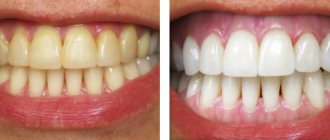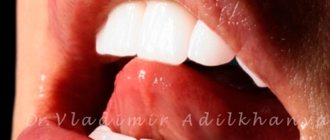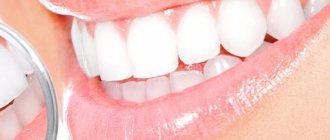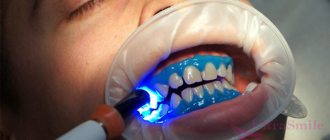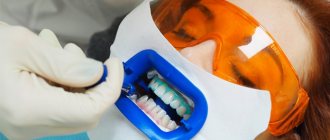One of the most popular services in cosmetic dentistry today is teeth whitening. In no way related to medicine, nevertheless, it is in great demand, because... in the minds of many of us, it is white (light) teeth that are an indicator of their health, as well as the high social status of their owner.
As I wrote earlier, such ideas were not always dogma, and how long such a fashion will last is unknown, but today it is so. I myself am neither a supporter nor an opponent of this procedure, and therefore I will try to talk about whitening as objectively and unbiasedly as possible. Moreover, I will do this in the form of questions and answers (i.e., a kind of FAQ on teeth whitening).
What is whitening and how does it differ from professional cleaning?
Very often patients say: “I want to whiten my teeth because... they have stains from coffee and cigarettes.” At the same time, they confuse 2 different procedures - teeth cleaning and teeth whitening. If brown plaque has accumulated on your teeth or stones have formed, then you need professional teeth cleaning, which is carried out with ultrasound, sandblasting (air-flow) or simply with a brush and a special professional abrasive paste. In this case, the dentist simply removes plaque from the surface of the teeth without changing their natural color. Although they become lighter, this is not bleaching. The whitening procedure involves the use of a strong oxidizing agent to lighten the actual tooth tissue. Hydrogen peroxide or carbamide peroxide, familiar to any unnatural blonde, is used as an oxidizing agent (it is approximately 2 times weaker than hydrogen peroxide). Penetrating into the internal structures of the tooth, the released active oxygen destroys the molecules of natural pigments, which leads to the fact that the tooth becomes lighter.
This is what plaque on teeth looks like, resulting from the abuse of cigarettes, coffee, and strong tea. It can be removed by professional cleaning, which has nothing to do with bleaching.
The dangers of bleaching dead growth
All of the above whitening methods can be harmful to the tooth. This applies to both healthy units and pulpless ones. If a tooth begins to decay, then in any case, if there is no timely and adequate treatment, it will completely crumble in 4-5 years. In this case, the person can get a crown or an implant.
Installing a crown is inexpensive. She can hold out for a long time. Such a prosthesis will completely repeat the shape of the lost process and perform all its functions. But a crown is placed in the case when the root of the unit is completely preserved.
Installing an implant is a more serious operation. During this process, the tooth and its root are completely removed. An implant is placed instead. The structure is implanted into the jaw bone and becomes an integral part of it.
It is believed that a healthy molar is better than an artificial one. But it is not always possible to keep natural shoots looking beautiful until old age. Therefore, sometimes it is worth seeking the help of a dentist to maintain the attractiveness of your smile even in old age.
If there is noticeable darkening of the enamel on a tooth, you should not waste time and immediately consult a doctor. He will choose the optimal method for restoring the unit, depending on the degree of its damage and the characteristics of the patient.
To avoid unpleasant situations with your teeth, you need to brush them regularly. To do this, you need to use pastes and brushes that are suitable for a particular type of teeth. You also need to constantly use rinse aids. You should choose such products after consulting a dentist.
What types of whitening are there? Which whitening method is more effective?
If we talk about really effective whitening, then there are only two types. Office and home. I repeat once again that the essence is the same everywhere. What's the difference then? Office work, as you might guess, is carried out in the dentist’s office. It is produced by gels with a high concentration of bleaching agent (usually 35-38% hydrogen peroxide). You cannot do procedures with such concentrations yourself, because contact of the gel of such concentrations with the mucous membrane causes severe burns. The doctor uses numerous means of protection so that only the teeth are whitened, and not the tongue or lips. Some whitening systems (Zoom, LumaCool, etc.) involve activating the gel with a special lamp for a faster and more effective procedure. Some are simply applied to the teeth and work without any additional activation by light (Opalescence, Bleach n' Smile , etc.) In any case, the procedure takes about 1-1.5 hours and the result can be seen almost immediately. Especially in systems with light activation of the gel.
This photo shows the process of in-office whitening with the Opalescence XtraBoost system, which I prefer to use in my practice. The green arrows indicate the actual whitening gel (38% hydrogen peroxide), the blue arrows indicate the protective coating of the gums (the so-called “liquid dam”), the black arrows indicate a temporary plastic crown, which does not whiten and will be replaced with a permanent one after completing the whitening course.
Home whitening involves the patient performing the procedure independently at home. BUT! Under the supervision of a doctor exclusively! Ideally, you come to the doctor, in 1-2 days they make a special plastic individual mouthguard for your teeth, give you instructions on what gel, what concentration and according to what scheme is best to use in your case. And then at home you do everything exactly as the doctor ordered. Results can usually be seen within a couple of weeks. Exactly the same result as with the cabinet version.
The custom tray is filled with whitening gel and placed over the teeth. Mouthguard wearing patterns vary and must be selected individually by the dentist.
Let's summarize the pros and cons of teeth whitening options . In-office treatment is faster, but it is usually more expensive and is often associated with the appearance of unpleasant sensitivity, both during the procedure and for some time after it. Home whitening will give a similar result over a longer period, but it is cheaper and, as a rule, does not cause discomfort in the form of increased tooth sensitivity. In cases where the result is not required right now (unexpected wedding, urgent important date, etc.), it is better to choose home whitening. But if you are not confident in your accuracy, you don’t want to spend a long and tedious time remembering all the rules and following all the recommendations, prefer a less complicated office option.
If you suddenly have an important event in your life that you need to approach with a dazzling smile, then in-office whitening is your choice.
Clinical researches
Clinical experiments with the use of the Asepta series of products, conducted at the Ryazan State Medical University named after Academician I.P. Pavlova of the Ministry of Health and Social Development of the Russian Federation (GBOU VPO RyazSMU Ministry of Health and Social Development of Russia) have proven that the use of Asepta line products results in a decrease in complaints of discomfort, but bleeding persists when brushing teeth.
On examination, hyperemia and bleeding of the gingival papillae are noted. On the 7th day, complaints of gum bleeding persisted in 4 patients. Upon examination, a decrease in hyperemia and swelling of the gums was noted, but bleeding persisted upon probing. On day 14, 2 patients continued to complain of bleeding gums when brushing their teeth; upon examination, a significant decrease in hyperemia and swelling of the gums was noted. After the final application of the gel with propolis, normalization of clinical manifestations was revealed, which is manifested by the absence of bleeding during brushing and probing.
Clinical experience in using the Asepta series of products Fuchs Elena Ivanovna Assistant of the Department of Therapeutic and Pediatric Dentistry State Budgetary Educational Institution of Higher Professional Education Ryazan State Medical University named after Academician I.P. Pavlova of the Ministry of Health and Social Development of the Russian Federation (GBOU VPO RyazSMU Ministry of Health and Social Development of Russia)
Report on determining/confirming the preventive properties of toothpaste “ASEPTA PLUS” GENTLE WHITENING” Author: doctor-researcher A.A. Leontyev, head Department of Preventive Dentistry, Doctor of Medical Sciences, Professor S.B. Ulitovsky First St. Petersburg State Medical University named after. acad. I.P. Pavlova, Department of Preventive Dentistry
Report on the determination/confirmation of the preventive properties of personal oral hygiene products “ASEPTA PLUS” Remineralization doctor-researcher A.A. Leontyev, head Department of Preventive Dentistry, Doctor of Medical Sciences, Professor S.B. Ulitovsky First St. Petersburg State Medical University named after. acad. I.P. Pavlova, Department of Preventive Dentistry
Will my teeth have sensitivity after the whitening procedure?
I began to partially answer this question in the previous paragraph. In each case, the manifestation of hypersensitivity during and after the procedure cannot be predicted; everything is quite individual. Generally speaking, the appearance of increased sensitivity of bleached teeth to one degree or another manifests itself after any whitening method. The faster the procedure occurs, the higher the concentration of the whitening gel, the stronger and longer the discomfort. Therefore, according to the degree of severity of unpleasant sensations, we can rank the procedure options as follows: in-office with the use of activating lamps gives complications more often and the intensity of unpleasant sensations is higher, in-office without activating the gel with light - less, home - least often, up to complete absence. One way or another, there is no need to be afraid of this. Usually, however, the sensitivity is not very intense and lasts a maximum of a few days. In addition, there are special products to reduce tooth sensitivity that you can use during this period. In some whitening systems, they come complete with all consumables for the procedure, and are given to you by the doctor.
Stages of intracanal bleaching
The procedure itself takes only 20 minutes, but for a high-quality and effective result, careful preparation is required.
Diagnostics
The doctor conducts a visual examination and also uses additional methods to determine the condition of the tissues, the quality of previous treatment and the cause of darkening of the tooth - as a rule, this is the loss of the pulp, but sometimes the causes may be trauma and hemorrhage of the still living pulp or age-related changes in which the tooth cannot be whitened other methods.
Making an appointment does not oblige you to anything, you can cancel your appointment at any time
Make an appointment
Preparation
The specialist removes all traces of carious lesions and cleans the cavity of filling material, tissue particles or the pulp itself, if it has not already been removed. The tooth is treated with an antiseptic solution and isolated with a rubber dam.
Whitening
The whitening gel is injected into the pulp cavity using a syringe applicator, then a temporary filling is installed for 2-3 days, after which the manipulations are repeated. The procedure lasts less than half an hour and is completely painless. To obtain the desired result, whitening should be carried out 1 to 3 times, the exact duration of the course is determined by the doctor. At the last visit, the dentist cleans the cavity of any remaining gel and places a permanent filling.
In-canal whitening
Is teeth whitening a harmful procedure?
As one medieval doctor said, “All poison is just a matter of dose.” The same can be said here. It is no secret that there is absolutely no benefit from bleaching in the medical sense. But there will be no harm from a competently carried out procedure. Suffice it to say that in the USA the bleaching procedure is very popular, and is generally equated to hair lightening, because... they even carry it out in shopping centers, not seeing any sedition in it. Therefore, if you really want to, bleach it. Only under the supervision of a doctor. In addition, the teeth on which the gel will be applied must be healthy, they should not have leaky fillings or caries. The dentist should check all this before you go into all serious troubles. He should also choose the best whitening method specifically for you and your teeth . Suggest the correct scheme for using products for home use, explain the features of dental care, etc. and so on. In general, conduct a full briefing and control. Only in this case the procedure will be as safe as possible and will bring nothing but a refreshed, white-toothed smile (if you are dreaming of it).
Teeth whitening looks so unpretentious and mundane in many shopping centers in the United States. While your wife is replenishing her wardrobe, and her beloved mother-in-law is replenishing her refrigerator, you can lie down and benefit your appearance.
Causes of darkening of pulpless teeth
The procedure is carried out solely at the request of the patient, as it mainly serves only an aesthetic function. Most often, forced lightening is required for dead incisors or fangs, since they are always visible, and if the shade of the enamel differs even by a couple of tones, it will be noticeable.
Teeth from which the pulp, that is, a collection of blood vessels and nerve endings, have been removed are considered dead. It is because of them that we feel pain, which warns of the presence of problems: the development of caries, internal trauma, etc.
In the absence of pulp, hard tissues cease to receive nutrition. What we see is no longer a tooth, but its shell, like a tree without roots. Such an incisor or molar will most likely not look the same, much less function. The consequences begin to be noticeable about a month after pulp removal. Dentin and enamel, as well as the main mineral part of the tooth, weaken and dry out. All these processes make the structure of solid tissue more porous.
Without constant replenishment, the tooth becomes defenseless and what was previously not a particular problem becomes more dangerous for it. It better absorbs pigments from food, for example, coffee, tea, alcohol, colored lemonades, berries and fruits, chocolate and other products with a high content of dyes. A pulpless tooth is like a sponge, so dyes accumulate in it faster, which means that after some time its shade begins to differ from the general tone of other teeth. If this is the reason for the color change, then standard whitening with an active gel is performed.
But there are also more complex problems when a canine or molar darkens from the inside. This happens precisely because of the removal of the pulp. Usually, those nerves that are damaged for one reason or another or interfere with the normal treatment of diseases such as tooth decay are removed. This removal may damage blood vessels, causing bleeding inside the canal. The dentin of a healthy tooth stains even more quickly than the enamel of dead hard tissue. Due to bleeding, the tooth becomes red and sometimes has a purple tint. In this case, standard bleaching will not help, since it mainly affects the outer layers of the fabric.
How effective and harmful are whitening toothpastes?
Here it must be said that the vast majority of so-called whitening pastes are actually not capable of whitening anything, because... they simply lack an oxidizing agent. So this is a kind of advertising ploy by the manufacturers. But what they do have is a higher content of abrasive substances for more effective plaque removal. You should not use such toothpastes regularly; it can cause serious harm to your teeth. At a minimum, this may threaten the appearance of increased sensitivity of teeth , and at a maximum, the appearance of non-carious lesions (mainly wedge-shaped defects). They can be used only temporarily (no more than one medium tube is used up) and it is advisable to alternate it with regular toothpaste. It is needed primarily by heavy smokers and coffee lovers. If you are not one of them, then you should not turn your attention to “whitening” toothpastes. In some rare cases, whitening toothpastes do contain small amounts of a bleaching agent. And such a paste really has the right to be called “whitening.” They are sold more often in pharmacies and are much more expensive than regular pastes. But even with regular use, you should not count on a noticeable effect from their isolated use. Concentrations are too low. As a rule, they are used for the period while the home whitening process is in progress to enhance and maintain the effect.
Here you can also talk about other “pharmacy” products for teeth whitening – various varnishes, strips, etc. All of these are very ineffective drugs for the same reason - a low concentration of the bleaching agent. To feel the results from them, you need to have a very high power of self-hypnosis. So it's just wasted money.
Signs of a Dead Tooth
When dentists say “dead tooth,” what does it mean? This means that there are no living tissues left in it, and only dentin and enamel are preserved. Externally, this can be recognized by the following signs:
- Immediately after depulpation, the tooth may be grayish, but over time it becomes darker.
- The reaction to cold and hot foods disappears.
- The tooth may be affected by caries, but pain is not felt even from sweet food getting into the hollow.
- Over time, the gray tooth gradually crumbles and collapses.
What effective folk whitening remedies exist? How to whiten teeth at home?
This question could be answered briefly: there are no effective traditional methods of teeth whitening . And I would like to warn against the thoughtless use of improvised means in order to save money. Very often this backfires. It is strictly forbidden to use soda, tooth powders, lemon, activated carbon, etc. to brighten your smile. in different combinations. I personally once had a patient who spent a considerable amount of time brushing her teeth with a mixture of baking soda and lemon juice. When she came to me, I learned for the first time what enamel erosion looks like. At that time I had not yet photographed clinical cases, but it looked something like this.
How do you like this “whitening”? Instead of beautiful teeth, they were irreparably damaged and their restoration cost her a lot of money. As usually happens, thoughtless savings turned into even greater expenses.
I also heard a story from colleagues about how one of the patients whitened his teeth with “Toilet Duck”, because the bottle said “safe for enamel.” Well, what else can you say?
to whiten your teeth on your own online . Most of them are just a waste of time. And some are simply harmful. So, in pursuit of beauty, do not lose your sanity, otherwise you risk losing your teeth. Ultimately, if you need to post your photo on a social network or forum, you can whiten your teeth using Photoshop (as they do in glossy magazines for unnaturally white-toothed models). Or if you need white teeth for some important occasion, you can visit the solarium several times, use a foundation of a darker shade... against the background of dark skin, the teeth will appear lighter even without any bleaching (just look at the “tanned” Africans, whose teeth are always appear dazzlingly white just because of the color of their skin).
The essence of modern whitening methods
Author of this article:
There are a huge number of ways to whiten teeth. This can be done both in dentistry and without leaving home. But not all methods are equally effective and safe.
Let's first look at modern types of teeth whitening in dentistry. These are the most reliable options, because any clinic guarantees you results after the first procedure.
So, in dental clinics there are the following types of teeth whitening:
- Chemical
- Laser
- Ultrasonic
- Photobleaching
- Alternative options
Is it possible to whiten a dead, darkened tooth?
Yes, and this procedure is called endobleaching . Those. internal tooth whitening. It may be needed when, after removing a nerve in a tooth, for various reasons it becomes dark, turns yellow and begins to stand out from its healthy neighbors. In this case, access to the canal is made in the tooth, it is reliably isolated, and the same hydrogen peroxide/urea whitening gel remains in the cavity for 2-3 days. As a result, the darkening of the dead tooth can be eliminated. Often this procedure must be performed before prosthetics of the front teeth with metal-free crowns or veneers. Due to their fairly high transparency (which is very necessary from an aesthetic point of view), any change in the color of the tooth underneath will be unpleasant to show through. This may prevent you from making restorations of the same color.
Upper central incisor darkened after depulpation
The same after the internal bleaching procedure
Preparation for the procedure
Initially, the doctor takes an x-ray. Then the mucous membrane in the mouth and gums are treated. They are coated with varnish to protect them from the gel. Next, the mixture is applied to the damaged molar. In order for it to actively start working, it is exposed to laser or ultraviolet light.
If darkening of the teeth occurs due to internal hemorrhage in the canals, then the doctor must initially clean them. This may require opening them. Next, the active substance is injected into the canals and a filling is placed.
So a person can pass a certain time until the color of the enamel becomes natural. Then a permanent filling is placed.
What is restorative bleaching? Is it possible to whiten teeth with veneers?
Restorative bleaching is, in most cases, a great stupidity that some doctors suggest that their patients do to themselves. This procedure involves covering the front surface of the teeth with a thin layer of white opaque composite material (it was popular in the past), or the same white opaque ceramic veneers/lumineers. In both cases, an irreversible change in the surface of a healthy tooth is assumed. In the case of a composite, you get a very dubious option from the point of view of aesthetics and service life. Well, about all kinds of “ veneers without grinding teeth/lumineers/ultraneers , etc.” you can read it here. In what cases can this option be used? There is only one good indication here – serious generalized (i.e. on all teeth at once) changes in their color. Such problems may be associated with impaired development of tooth buds in childhood or even in the womb. The most common of these pathologies are the so-called. tetracycline teeth.
This is what one of the unpleasant lesions of teeth looks like during their development, the so-called. "tetracycline teeth"
You can also resort to total restoration of all visible teeth if you desperately need teeth the color of plumbing fixtures - absolutely white. It will never be possible to whiten healthy, normal teeth to such a state using any method, and attempts to do so can still end disastrously for the teeth. So if you are a movie and TV star, and your mouth is periodically shown in close-up on the entire screen throughout the country, and the size of your future fees depends on the degree of whiteness of your teeth, then restorative bleaching is quite an option for you... After all, against the background of circular braces , liposuction, enlargement/reduction of everything that can be enlarged/reduced, total teeth veneering looks like a completely innocent and absolutely safe children’s prank.
You can whiten teeth with fillings
Before you go for a whitening procedure, you should consult with a specialist and weigh all the risks. The main thing with this type of whitening is to pay attention to detail.
What material is the filling made of?
Before deciding on whitening, find out what material the filling is made of. The result obtained directly depends on this.
- Photopolymer is a modern material that is most similar to dental bone tissue and can whiten just as well as natural teeth .
- Budget filling materials - there is a high probability that the tooth will whiten, but the filling itself will not change its color.
Filled tooth
Filling size
A small and inconspicuous filling will not interfere with the procedure. The larger the filling, the higher the likelihood that it cannot be whitened. The best solution in this case would be to replace the filling material, choosing a shade more suitable for the teeth.
Do fillings whiten?
As mentioned earlier, this directly depends on the type of filling and the materials used. Most dentists discourage patients from whitening their filled teeth, and for good reason.
If you whiten a tooth that consists of more than half of the filling material, it will eventually acquire a spotted structure and this will be very noticeable. If the front teeth have been filled, then the best solution would be to cover them with veneers.
Veneers look very natural and, unlike tooth enamel, never change color.
Moreover, professional whitening somewhat weakens the enamel structure, which is undesirable for teeth that have previously been filled. This makes them more susceptible to tooth decay and demineralizes them.
How to care for whitened teeth?
Immediately after the whitening procedure, for 2-3 days it is better to refrain from coloring products - wine, berry jam, strong tea (especially cheap... from bags in which nothing but paint is poured, not even tea leaves), coffee, smoking (if possible ) and so on. If increased sensitivity occurs after the procedure, you can use a special paste for sensitive teeth (Lacalute Sensitive, Sensodyne) or ask your dentist for a special gel to reduce sensitivity, which often comes in the same set with a whitening gel. In the future, no specific care for whitened teeth is required. Over time, their natural color will be restored. In this case, you can conduct a short maintenance course of home whitening, after consulting with your dentist. Typically, such a need arises no more often than every 6 months to 1 year.
Preparatory process
The procedure for whitening pulpless teeth is somewhat different from the treatment of healthy ones, in which an active concentrated substance is applied to their outer part. But dead molars and incisors change color from the inside, so that's where the whitening agent must work.
Before the procedure begins, an x-ray of the patient's teeth is taken to ensure the correctness of the canal treatment. Then the cavity of the pulpless hard tissues is re-opened and cleaned.
It is important that during the treatment process the active substance does not penetrate into the root of the dead tooth, so that tissue irritation does not occur in the area of the upper part of the tooth socket. The canal is sealed using cement or composite.
Whitening sensitive teeth
Not so long ago, experts were hesitant to whiten sensitive teeth.
Modern dentistry can cope with any, even the most neglected teeth, brightening them and giving them a healthy appearance. But it should be noted that whitening is a medical procedure that has its own number of contraindications.
These include:
- Individual intolerance to any components of bleaching products.
- Pregnancy and breastfeeding.
- Smoking.
- Abuse of coffee and strong tea.
- Presence of carious teeth.
- The presence of fillings of dubious quality with a broken seal.
- Active processes of inflammatory nature of the gums.
The presence of any of the above problems is a reason to postpone the whitening procedure.
What is laser whitening? Is it true that it is the most effective?
Laser whitening/photo whitening (I came across other names) - all of this is essentially the same thing. In order to stand out from the crowd and offer patients something “unique... and only here,” clinic advertisers come up with a bunch of names for the same procedure. All this is standard whitening with gels, which are activated by the light of special lamps. Indeed, such systems (Zoom, LumaCool, LumaArch and many others) give the fastest and most noticeable results. But at the same time they also give the greatest number of cases of the development of very intense hypersensitivity. Plus, due to the rather high cost of consumables required for each procedure, the high cost of the lamp itself, which must be “beaten”, the price for such a service turns out to be the highest of all possible options for whitening procedures. But the choice is ultimately yours. Do you want instant results visible to the naked eye? Pay with money and discomfort from pain. Do you want it cheaper and with a minimum of discomfort? Then be patient and forget about “laser” whitening.
The generation of advertisers who grew up watching Star Wars apparently imagines the dentists of the future in this way, luring patients to clinics for “laser treatment of caries,” “laser whitening,” and “laser implantation.”
In fact, this is what the Zoom lamp for “laser” (i.e., actually conventional, light-activated) whitening looks like these days.
Contraindications for endobleaching
Like any chemical teeth whitening, intracanal whitening procedure is carried out only in the presence of intact hard tissues. If caries is diagnosed on the crown or an inflammatory process of periodontal or periodontal tissues is detected, then the endobleaching procedure is possible only after complex therapy of the diseased tooth. Limitations may include the following factors:
- Pregnancy or breastfeeding period.
- The likelihood of an allergic reaction to the components of the bleaching agent.
- Composite restorations that have changed shade over time.
- For carious organ damage.
- For enamel hypersensitivity.
Intracoronal bleaching is limited in the number of times this method can be used. The bleaching agent weakens the enamel of the dental crown, so the procedure is allowed to be used no more than four times. Otherwise, there is a high probability that the tooth will not withstand the chewing load and will break during eating.
Are artificial crowns and fillings bleached?
No. No crowns or fillings can be whitened using any method. Therefore, after lightening your teeth, you will have to replace any restorations with those that are visible when you smile and talk. If your teeth have caries or leaky fillings, then before whitening a temporary restoration is made, which, after all lightening procedures are completed, is changed to a permanent one, taking into account the resulting shade of the teeth.
This photo shows that the plastic temporary crown, originally made to match the color of the neighboring teeth, after the whitening procedure stands out strongly against the background of its lighter neighbors
These are the main questions about teeth whitening that I have encountered. This article will be updated as new ones appear. If you are thinking about this fashionable procedure, remember that beautiful teeth are, first of all, healthy teeth. And in attempts to improve their appearance, you should not harm them with dubious methods or independent exercises using improvised means.
What to choose?
The lightening procedure is carried out at will. Often the frontal incisors and canines are lightened, because they are visible. If their shade differs by one or two shades, it is already noticeable to others. Lightening is a serious manipulation, as it involves chemical exposure. Therefore, it must be carried out by a dentist so that the result is long-lasting and the shade does not differ from the color of healthy teeth. To prevent the crowns from being destroyed or crumbling, the manipulation must be carried out by a specialist. Only a qualified dentist will protect the gum tissue from irritation by protecting it with special means. Also, the doctor will choose a safe method of action.
- An alternative to lightening from the inside are inlays and crowns, if the organ is not severely damaged. This solves the problem of color, as well as strengthening the unit, and reduces the risk of further destruction.
- The technology of restoration with veneers is suitable for patients with crooked, spotted teeth, the crown layer of which is slightly destroyed.
- Lightening from the inside is necessary when dentin darkens when other methods do not give results.
To avoid unpleasant situations, you should carefully care for your oral cavity, regularly visit the dental office, carry out timely sanitation and treatment of carious cavities. Taking care of the oral cavity is the key to the health of the whole body.
